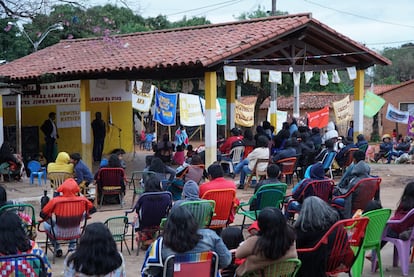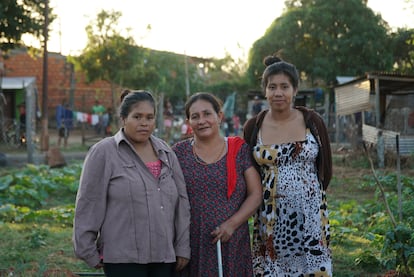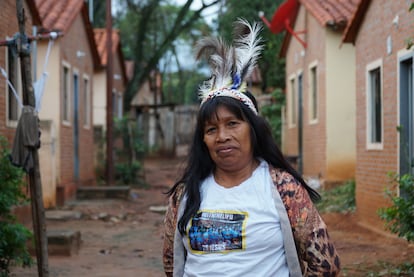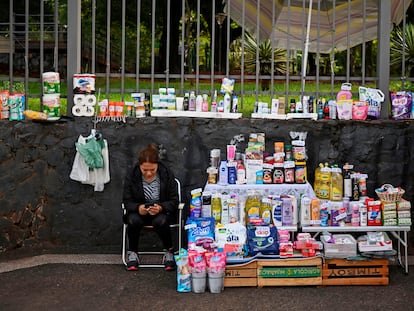Paraguayan Guaraní, the language of resistance
It is estimated that some 10 million people speak it, especially in Paraguay, Brazil, Argentina, and Bolivia. It is also an official language of the Mercosur trade bloc
Every August 25, Paraguay celebrates Guaraní Language Day. It commemorates the day in 1967 on which it was included as a national language and granted legal status. Guaraní is widespread in Paraguay and is the only language of American origin spoken by the majority of a non-indigenous population. Fundamentally, it is a language of oral transmission, which is essential in the countryside and very common in cities. “Mba’e la porte?” “How are you?” they greet each other in a street in the center of Asunción. “Iporânte. Ha nde?” ”Fine, and you?” they answer. And the conversation continues in a mixture of Guaraní and common Spanish words, which they call jopará.
7.5 million people live in Paraguay and 70% of the population over the age of 5 habitually speaks Guaraní, according to the 2022 Permanent Household Survey of the National Institute of Statistics. Although it has been recognized for more than half a century, it did not become an official language (along with Spanish) until 1992. Eighteen years later, in 2010, during the Frente Guasú government of Fernando Lugo, the Languages Law was approved, the regulation of article 140 of the Constitution by which the Secretariat of Linguistic Policy and the Academy of the Guaraní Language were established. The latter is the main institution in charge of regulating and standardizing the language and has created a dictionary, grammar, and orthography. Since June 2021, it is mandatory for all public institutions to offer services in both official languages, but this has not yet been fulfilled.
The resistance of Paraguayan Guaraní
Paraguayan Guaraní did not exist before the Spanish conquest, which began in 1524. It is nearly 500 years old and was formed from the region’s languages coming into contact with Spanish. Originally lacking a written form, it was the Franciscan and Jesuit missionaries who developed an orthography based on the Latin alphabet, in addition to the first grammars and dictionaries. This is something that has possibly contributed to preserving some features through the centuries, but has also uncoupled the language from its culture. “The Guaraní that is taught in the academy is close to Avá Guaraní, but it also has elements from other peoples,” says Perla Álvarez, a 52-year-old linguist. She is a mbo’ehára (teacher) at the Ateneo de Lengua y Cultura Guaraní (Guaraní Language and Culture Center), which was founded in 1985, and for a year she has also been one of the 30 people that make up the Guaraní Ñe’ẽ Rerekuapavẽ, the Guaraní Language Academy.
“Paraguayan Guaraní is a symbol of resistance,” says Álvarez at her home in the Historic Center of Asunción. Despite the lack of an institutional effort to conserve the language during the military dictatorship of Alfredo Stroessner (1954-1989), the town has kept it alive. Like many people her age, she understood Guaraní as a child, but did not speak it. “Even though my parents used it, they only let me practice it during ‘Guaraní time,’ once a week. During the dictatorship it was socially prohibited — not by law, but it was considered an uneducated, backward, language of peasants and the poor; so many families preferred their children not to learn it. It was kept only for domestic and folklore use,” she explains.

Álvarez began to express herself in Guaraní at the age of 25, when she became interested in the language and decided to learn it seriously. “Paraguayan bilingualism is of great sociolinguistic interest,” she says. She tries to bridge the gap between academic and vernacular Guaraní. She believes that there is still a lot to improve in Guaraní language teaching in Paraguayan schools. “It is not bilingual, there are only two hours of Guaraní class a week and it’s done in a very technical way, something that sometimes overwhelms the students, who also notice the difference with what is spoken on the street.”
The 19 native languages of Paraguay
The Guaraní that is currently widespread in Paraguay is different from the country’s 19 native languages, which predate it and are part of five linguistic families: Guaraní, Mataco Mataguayo, Maskoy language, Guaicurú and Zamucu. This richness and diversity is not reflected in the official discourse of Paraguayan bilingualism. Within the Guaraní family are the Aché, Avá Guaraní, Mbya Guaraní, Paï Tavytera, Nandeva Guaraní, and Western Guaraní languages, all with notable differences. For example, in Mbya Guaraní “hello” is aguyjevete but in Avá Guaraní, it is mba’éichapa.
Most of the members of the 19 Indigenous peoples live in communities scattered throughout the country. They are marginalized and subsist in precarious conditions. Some are seriously threatened, such as the Guaná, Tomárãho, Angaité, Manjui, Sanapana, and Avá Guaraní.
Petrona Ruidia, 43 years old, belongs to the Avá Guaraní people and is the guazu (great leader) of the native community of Cerro Poty, in the city of Asunción. Three native peoples live there, surrounded by trash and barely maintaining their three respective cultures and languages: Mbya Guaraní, Avá Guaraní, and Angaité. The leader understands Spanish perfectly, but expresses herself better in Guaraní. Her neighbors and school teachers, Eida Pereira and Leiny Gómez, are with her and help translate her words.

Petrona came to the community of Cerro Poty 25 years ago from Salto del Guairá, on the border with Brazil, because her people did not agree to pay to occupy the land for which they were beginning to be charged. “35 families live here and we don’t want to be evicted. The community began to form almost 30 years ago, from two families,” she says next to the orchard where they cultivate the land to produce food. There are pigs and chickens nearby. The community is fenced, has a school, soccer field, playground, and a space for MAIPY Mesa de Articulación Indígena del Paraguay (MAIPY), an Indigenous pressure group meetings, from where they fight for their rights.
At the other end of Asunción is the Maká community of Mariano Roque Alonso, led by Mateo Martínez Mateiko. He is the son and grandson of Indigenous leaders, who was chosen to represent his community, a responsibility he has taken on for 37 years. “I arrived from El Chaco in 1986 and since then we have grown a lot. More than 2,000 Maká live here, according to the last census. Most work in crafts. It is the largest Maká community because it is estimated that in total there are less than 3,000 Maká in Paraguay,” he explains in the main square. This Friday afternoon is packed because the community is celebrating his birthday with musical performances.
“One of the main demands of the native communities is that our educational system be recognized and respected,” says Mateiko, who regularly meets with other leaders of Indigenous peoples. “We request our own curriculum and that it be recognized by the MEC [Ministry of Education and Sciences]. It is a fight that we have had for a long time. For example, our school should have more art classes and Maká teachers, but there is only Guaraní.” The Maká language belongs to the Mataco Mataguayo family, not Guaraní. Mateiko trusts that the new government pays more attention to their culture and language through the General Directorate of Indigenous School Education, which depends on the MEC.
Educational policies and didactic material
“The original peoples lack teachers, materials, and the regulation of their own lives. For example, the Maká are losing their language. And that is happening in almost all of the 19 native languages, which are being supplanted by the official Guaraní,” says Carlos Ferreira Quiñonéz, president of the Guaraní Language Academy.
The 63-year-old doctor of Guaraní Language and Culture believes that the government of Paraguay has turned its back on the native languages and that a better education policy needs to be developed. He regrets that Santiago Peña, from the Colorado Party, did not speak Guaraní in his first speech as president, on August 15. “He only used the word aguyje, which means thank you. You have to speak to the people in their language. How is he going to communicate with farmers, fishermen, and many other Paraguayan workers who speak nearly 100% of the time in Guaraní?” the academic asks.
Despite the deficiencies, Ferreira celebrates that in general, interest in language conservation is increasing. “In 1900, the texts in Guaraní could be counted on the fingers of one hand, but from the 1990s there has been an explosion, reaching 2,000 texts in 2012. Now more than 1,500 are published every year,” he says. Nazar Chaile has closely followed this increase. He has worked in the Paraguayan Chamber of Publishers and Booksellers (CAPEL) for 30 years. “There is more and more supply and demand, but there is still a lack of teaching materials, adapted to different profiles,” he acknowledges. Today he is working at the stall they have set up in Juan E. O’Leary square, in the heart of Asunción, on the occasion of the August 15 celebrations, the date the capital was founded. The only material they offer to spread Guaraní is the game Ñañe’ẽ, which means “let’s talk.” He shows a cardboard box containing decks of cards with which to form sentences in Guaraní.
“The idea is to bring people closer to the language through games and art, to combine motivation and emotion in the learning process,” says its creator, designer, and communicator Rebeka Nadir. She decided to embark on the multimedia project www.culturaGuaraní.com in 2017 to contribute to the spread of the language and adapt it to new generations and technologies. “Guaraní is not given enough importance at school. There is a lack of attractive teaching materials, and so Guaraní ends up becoming a very boring subject. That’s why I decided to design a game for all ages from the age of six, which teaches the structure of the language in an intuitive way. We tried it in schools and the children had a lot of fun,” she explains.
The new Minister of Education and Science appointed by President Santiago Peña is the sociologist and educational counselor Luis Ramírez, who is aware that he is in charge of one of the largest and most important portfolios for the development of a country. Among the many challenges he will face is improving the quality of Guaraní teaching and preserving Paraguay’s 19 native languages.

Sign up for our weekly newsletter to get more English-language news coverage from EL PAÍS USA Edition
Tu suscripción se está usando en otro dispositivo
¿Quieres añadir otro usuario a tu suscripción?
Si continúas leyendo en este dispositivo, no se podrá leer en el otro.
FlechaTu suscripción se está usando en otro dispositivo y solo puedes acceder a EL PAÍS desde un dispositivo a la vez.
Si quieres compartir tu cuenta, cambia tu suscripción a la modalidad Premium, así podrás añadir otro usuario. Cada uno accederá con su propia cuenta de email, lo que os permitirá personalizar vuestra experiencia en EL PAÍS.
¿Tienes una suscripción de empresa? Accede aquí para contratar más cuentas.
En el caso de no saber quién está usando tu cuenta, te recomendamos cambiar tu contraseña aquí.
Si decides continuar compartiendo tu cuenta, este mensaje se mostrará en tu dispositivo y en el de la otra persona que está usando tu cuenta de forma indefinida, afectando a tu experiencia de lectura. Puedes consultar aquí los términos y condiciones de la suscripción digital.
More information
Archived In
Últimas noticias
Maduro pleads not guilty before the federal court in New York: ‘I am still the president of Venezuela’
A new test can detect Alzheimer’s from a finger prick
UN team enters Sudanese city of El Fasher after paramilitary massacre: ‘It’s like a ghost town’
A recipe for resistance: Indigenous peoples politicize their struggles from the kitchen
Most viewed
- Gilles Lipovetsky: ‘If you want to live better and fall in love, take Prozac, don’t look to philosophy’
- Alain Aspect, Nobel laureate in physics: ‘Einstein was so smart that he would have had to recognize quantum entanglement’
- Alvin Hellerstein, a 92-year-old judge appointed by Bill Clinton, to preside over Maduro’s trial in New York
- Maduro’s downfall puts China’s relationship with Venezuela to the test
- Why oil has been at the center of Venezuela-US conflicts for decades









































